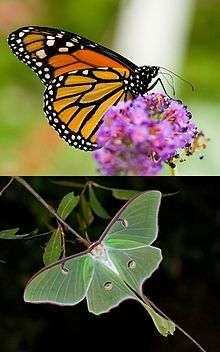Lepidopterology
Lepidopterology (from Ancient Greek λεπίδος (scale) and πτερόν (wing); and -λογία -logia.),[1] is a branch of entomology concerning the scientific study of moths and the three superfamilies of butterflies. Someone that studies in this field is a lepidopterist (or aurelian).
History
Post-Renaissance, the rise of the "lepidopterist" can be attributed to the expanding interest in science, nature and the surroundings. When Linnaeus wrote the tenth edition of the Systema Naturae in 1758, there was already "a substantial body of published work on Lepidopteran natural history" (Kristensen, 1999).[2]
These included:[2]
- Insectorum sive Minimorum Animalium Theatrum – Thomas Mouffet (1634)
- Metamorphosis Naturalis – Jan Goedart (1662–67 )
- Metamorphosis insectorum Surinamensium – Maria S. Merian (1705), whose work included illustrated accounts of European Lepidoptera
- Historia Insectorum – John Ray (1710)
- Papilionum Brittaniae icones – James Petiver (1717)
Lepidopterological societies
Lepidopterists are served by a number of scientific societies, both national and international in scope. They promote research in lepidopterology and dissemination of the findings therefrom primarily through the arrangement of talks such as the biennial European Congresses of Lepidopterology or the TILS Leps Talk. These societies include:
- Lepidopterists' Society
- Societas Europaea Lepidopterologica
- Lepidoptera Research Foundation
- North American Butterfly Association
- Association for Tropical Lepidoptera
- International Lepidoptera Survey
- Lepidopterological Society of Denmark
- Lepidopterological Society of Finland
- Lepidopterological Society of Japan
- Sicilian Lepidopterological Association
- Southern Lepidopterists' Society
- Study Group of Hessian Lepidopterologists
- Lepidopterists' Society of Africa
Lepidopterological journals
- Journal of Research on the Lepidoptera
- Metamorphosis
- The Taxonomic Report
- Nota lepidopterologica
See also
- The Global Lepidoptera Names Index
- Lepidoptera in the 10th edition of Systema Naturae
- McGuire Center for Lepidoptera and Biodiversity, University of Florida
- Butterfly watching
References
- ↑ Harper, Douglas. "lepidoptera". The Online Etymology Dictionary. Retrieved 8 February 2011.
- 1 2 Kristensen, Niels P. (1999). "Historical Introduction". In Kristensen, Niels P. Lepidoptera, moths and butterflies: Evolution, Systematics and Biogeography. Volume 4, Part 35 of Handbuch der Zoologie:Eine Naturgeschichte der Stämme des Tierreiches. Arthropoda: Insecta. Walter de Gruyter. p. 1. ISBN 978-3-11-015704-8. Retrieved 30 November 2010.
